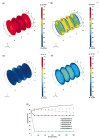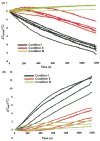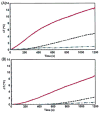Method to reduce non-specific tissue heating of small animals in solenoid coils
- PMID: 23402327
- PMCID: PMC3991111
- DOI: 10.3109/02656736.2013.764023
Method to reduce non-specific tissue heating of small animals in solenoid coils
Abstract
Purpose: Solenoid coils that generate time-varying or alternating magnetic fields (AMFs) are used in biomedical devices for research, imaging and therapy. Interactions of AMF and tissue produce eddy currents that deposit power within tissue, thus limiting effectiveness and safety. We aim to develop methods that minimise excess heating of mice exposed to AMFs for cancer therapy experiments.
Materials and methods: Numerical and experimental data were obtained to characterise thermal management properties of water using a continuous, custom water jacket in a four-turn simple solenoid. Theoretical data were obtained with method-of-moments (MoM) numerical field calculations and finite element method (FEM) thermal simulations. Experimental data were obtained from gel phantoms and mice exposed to AMFs having amplitude >50 kA/m and frequency of 160 kHz.
Results: Water has a high specific heat and thermal conductivity, is diamagnetic, polar, and nearly transparent to magnetic fields. We report at least a two-fold reduction of temperature increase from gel phantom and animal models when a continuous layer of circulating water was placed between the sample and solenoid, compared with no water. Thermal simulations indicate the superior efficiency in thermal management by the developed continuous single chamber cooling system over a double chamber non-continuous system. Further reductions of heating were obtained by regulating water temperature and flow for active cooling.
Conclusions: These results demonstrate the potential value of a contiguous layer of circulating water to permit sustained exposure to high intensity alternating magnetic fields at this frequency for research using small animal models exposed to AMFs.
Conflict of interest statement
Figures








Similar articles
-
Validation of a coupled electromagnetic and thermal model for estimating temperatures during magnetic nanoparticle hyperthermia.Int J Hyperthermia. 2021;38(1):611-622. doi: 10.1080/02656736.2021.1913244. Int J Hyperthermia. 2021. PMID: 33853493 Free PMC article.
-
Feasibility of heating metal implants with alternating magnetic fields (AMF) in scaled up models.Int J Hyperthermia. 2022;39(1):81-96. doi: 10.1080/02656736.2021.2011434. Int J Hyperthermia. 2022. PMID: 34949138
-
Application of high amplitude alternating magnetic fields for heat induction of nanoparticles localized in cancer.Clin Cancer Res. 2005 Oct 1;11(19 Pt 2):7093s-7103s. doi: 10.1158/1078-0432.CCR-1004-0016. Clin Cancer Res. 2005. PMID: 16203808
-
In silico evaluation of adverse eddy current effects in preclinical tests of magnetic hyperthermia.Comput Methods Programs Biomed. 2022 Aug;223:106975. doi: 10.1016/j.cmpb.2022.106975. Epub 2022 Jun 25. Comput Methods Programs Biomed. 2022. PMID: 35792363
-
Design and construction of a Maxwell-type induction coil for magnetic nanoparticle hyperthermia.Int J Hyperthermia. 2020;37(1):1-14. doi: 10.1080/02656736.2019.1704448. Int J Hyperthermia. 2020. PMID: 31918595 Free PMC article.
Cited by
-
HYPER: pre-clinical device for spatially-confined magnetic particle hyperthermia.Int J Hyperthermia. 2023;40(1):2272067. doi: 10.1080/02656736.2023.2272067. Epub 2023 Oct 24. Int J Hyperthermia. 2023. PMID: 37875265 Free PMC article.
-
Validation of a coupled electromagnetic and thermal model for estimating temperatures during magnetic nanoparticle hyperthermia.Int J Hyperthermia. 2021;38(1):611-622. doi: 10.1080/02656736.2021.1913244. Int J Hyperthermia. 2021. PMID: 33853493 Free PMC article.
-
Image-guided thermal therapy with a dual-contrast magnetic nanoparticle formulation: A feasibility study.Int J Hyperthermia. 2016 Aug;32(5):543-57. doi: 10.3109/02656736.2016.1159737. Epub 2016 May 5. Int J Hyperthermia. 2016. PMID: 27151045 Free PMC article.
-
Magnetic nanoparticle hyperthermia for treating locally advanced unresectable and borderline resectable pancreatic cancers: the role of tumor size and eddy-current heating.Int J Hyperthermia. 2020 Dec;37(3):108-119. doi: 10.1080/02656736.2020.1798514. Int J Hyperthermia. 2020. PMID: 33426990 Free PMC article.
-
Systemically delivered antibody-labeled magnetic iron oxide nanoparticles are less toxic than plain nanoparticles when activated by alternating magnetic fields.Int J Hyperthermia. 2020 Dec;37(3):59-75. doi: 10.1080/02656736.2020.1776901. Int J Hyperthermia. 2020. PMID: 33426997 Free PMC article.
References
-
- Ehrmann K, Saillen N, Vincent F, Stettler M, Jordan M, Wurm FM, et al. Microfabricated solenoids and Helmholtz coils for NMR spectroscopy of mammalian cells. Lab Chip. 2007;7:373–380. - PubMed
-
- Minard KR, Wind RA. Solenoidal microcoil design – Part I: Optimizing RF homogeneity and coil dimensions. Concepts Magn Reson. 2000;13:128–142.
-
- McCann C, Sherar MD. Development of a novel loosely wound helical coil for interstitial radiofrequency thermal therapy. Phys Med Biol. 2006;51:3835–3850. - PubMed
-
- Ellinger DC, Chute FS, Vermeulen FE. Evaluation of a semi-cylindrical solenoid as an applicator for radio-frequency hyperthermia. IEEE Trans Biomed Eng. 1989;36:987–994. - PubMed
Publication types
MeSH terms
Substances
Grants and funding
LinkOut - more resources
Full Text Sources
Other Literature Sources
